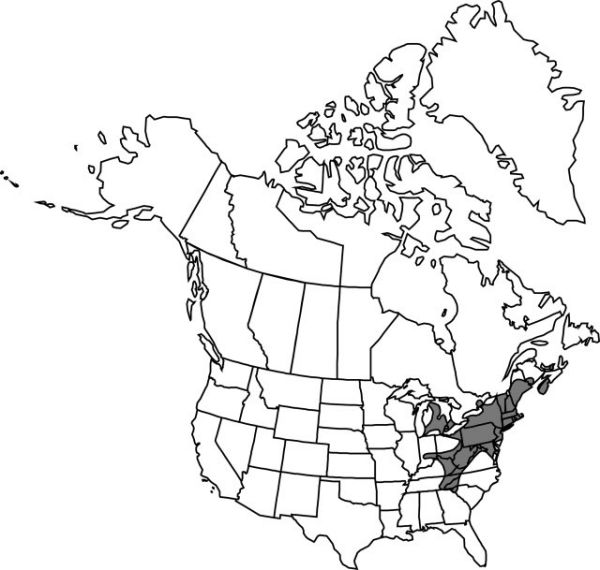Difference between revisions of "Spiranthes ochroleuca"
Fl. Plains N. Amer., 241. 1932.
FNA>Volume Importer |
imported>Volume Importer |
||
| (6 intermediate revisions by 2 users not shown) | |||
| Line 7: | Line 7: | ||
|year=1932 | |year=1932 | ||
}} | }} | ||
| − | |basionyms={{Treatment/ID/ | + | |special_status={{Treatment/ID/Special_status |
| + | |code=E | ||
| + | |label=Endemic | ||
| + | }} | ||
| + | |basionyms={{Treatment/ID/Basionym | ||
|name=Gyrostachys ochroleuca | |name=Gyrostachys ochroleuca | ||
|authority=Rydberg | |authority=Rydberg | ||
| + | |rank=species | ||
| + | |publication_title=in N. L. Britton, Man. Fl. N. States, | ||
| + | |publication_place=300. 1901 | ||
}} | }} | ||
|synonyms={{Treatment/ID/Synonym | |synonyms={{Treatment/ID/Synonym | ||
|name=Spiranthes cernua var. ochroleuca | |name=Spiranthes cernua var. ochroleuca | ||
|authority=(Rydberg) Ames | |authority=(Rydberg) Ames | ||
| − | }}{{Treatment/ID/Synonym | + | |rank=variety |
| + | }} {{Treatment/ID/Synonym | ||
|name=Spiranthes ×steigeri | |name=Spiranthes ×steigeri | ||
|authority=Correll | |authority=Correll | ||
| + | |rank=species | ||
}} | }} | ||
|hierarchy=Orchidaceae;Orchidaceae subfam. Orchidoideae;Orchidaceae tribe Cranichideae;Orchidaceae (tribe Cranichideae) subtribe Spiranthinae;Spiranthes;Spiranthes ochroleuca | |hierarchy=Orchidaceae;Orchidaceae subfam. Orchidoideae;Orchidaceae tribe Cranichideae;Orchidaceae (tribe Cranichideae) subtribe Spiranthinae;Spiranthes;Spiranthes ochroleuca | ||
| Line 32: | Line 41: | ||
|elevation=0–1700 m | |elevation=0–1700 m | ||
|distribution=N.B.;N.S.;Ont.;P.E.I.;Conn.;Ind.;Ky.;Maine;Md.;Mass.;Mich.;N.H.;N.J.;N.Y.;N.C.;Ohio;Pa.;R.I.;S.C.;Tenn.;Vt.;Va.;W.Va. | |distribution=N.B.;N.S.;Ont.;P.E.I.;Conn.;Ind.;Ky.;Maine;Md.;Mass.;Mich.;N.H.;N.J.;N.Y.;N.C.;Ohio;Pa.;R.I.;S.C.;Tenn.;Vt.;Va.;W.Va. | ||
| − | |discussion=<p>While leaves of Spiranthes ochroleuca are usually present at anthesis, in prairie populations they are commonly absent.</p><!-- | + | |discussion=<p>While leaves of <i>Spiranthes ochroleuca</i> are usually present at anthesis, in prairie populations they are commonly absent.</p><!-- |
| − | --><p>Spiranthes ×steigeri was described as a hybrid of S. cernua and S. romanzoffiana, but additional study (P. M. Catling 1984) has shown the plants to be referable to S. ochroleuca.</p><!-- | + | --><p><i>Spiranthes</i> ×steigeri was described as a hybrid of <i>S. cernua</i> and <i>S. romanzoffiana</i>, but additional study (P. M. Catling 1984) has shown the plants to be referable to <i>S. ochroleuca</i>.</p><!-- |
| − | --><p>See notes on gene flow and apomixis under 14. Spiranthes cernua.</p><!-- | + | --><p>See notes on gene flow and apomixis under 14. <i>Spiranthes cernua</i>.</p><!-- |
| − | --><p>Hybrids of Spiranthes ochroleuca with S. casei are known as S. ×borealis P. M. Brown.</p> | + | --><p>Hybrids of <i>Spiranthes ochroleuca</i> with <i>S. casei</i> are known as S. ×borealis P. M. Brown.</p> |
|tables= | |tables= | ||
|references={{Treatment/Reference | |references={{Treatment/Reference | ||
| Line 50: | Line 59: | ||
-->{{#Taxon: | -->{{#Taxon: | ||
name=Spiranthes ochroleuca | name=Spiranthes ochroleuca | ||
| − | |||
|authority=(Rydberg) Rydberg | |authority=(Rydberg) Rydberg | ||
|rank=species | |rank=species | ||
| Line 64: | Line 72: | ||
|publication title=Fl. Plains N. Amer., | |publication title=Fl. Plains N. Amer., | ||
|publication year=1932 | |publication year=1932 | ||
| − | |special status= | + | |special status=Endemic |
| − | |source xml=https:// | + | |source xml=https://bitbucket.org/aafc-mbb/fna-data-curation/src/2e0870ddd59836b60bcf96646a41e87ea5a5943a/coarse_grained_fna_xml/V26/V26_1098.xml |
|subfamily=Orchidaceae subfam. Orchidoideae | |subfamily=Orchidaceae subfam. Orchidoideae | ||
|tribe=Orchidaceae tribe Cranichideae | |tribe=Orchidaceae tribe Cranichideae | ||
Latest revision as of 21:11, 5 November 2020
Plants 10–55 cm. Roots few, horizontally spreading, slender, mostly to 0.4 cm diam. Leaves persisting through anthesis, basal, sometimes on basal portion of stem, spreading, linear-oblanceolate to narrowly elliptic, to 21 × 2 cm. Spikes rather loosely to very tightly spiraled, 3–4 flowers per cycle of spiral, occasionally 5 or more in very loose spiral; rachis moderately pubescent, some trichomes capitate, glands obviously stalked. Flowers ochroleucous, ivory, creamy, yellowish, or greenish white, ascending, urceolate to somewhat gaping, claw of lip at pronounced (20–60°) angle to lamina, base cuneate, appearing strongly inflated; sepals distinct to base, 6–14 mm; lateral sepals appressed to petals and lip, straight, separated from dorsal sepal by mostly 0.7–1 mm; petals linear to linear-oblong, 6–13 mm, apex acute to obtuse; lip often more yellow centrally, oblong to ovate, 7–12 × 4–7 mm, margins crenulate, glabrous; veins several, branches parallel; basal calli incurved, prominent, very rarely conic, 1–2 mm; viscidia linear; ovary 3–7 mm. Seeds monoembryonic. 2n = 30.
Phenology: Flowering Aug–Nov.
Habitat: Dry to mesic open woodland, thickets, meadows, barrens, ledges, outcrops, banks and roadsides, old fields
Elevation: 0–1700 m
Distribution

N.B., N.S., Ont., P.E.I., Conn., Ind., Ky., Maine, Md., Mass., Mich., N.H., N.J., N.Y., N.C., Ohio, Pa., R.I., S.C., Tenn., Vt., Va., W.Va.
Discussion
While leaves of Spiranthes ochroleuca are usually present at anthesis, in prairie populations they are commonly absent.
Spiranthes ×steigeri was described as a hybrid of S. cernua and S. romanzoffiana, but additional study (P. M. Catling 1984) has shown the plants to be referable to S. ochroleuca.
See notes on gene flow and apomixis under 14. Spiranthes cernua.
Hybrids of Spiranthes ochroleuca with S. casei are known as S. ×borealis P. M. Brown.